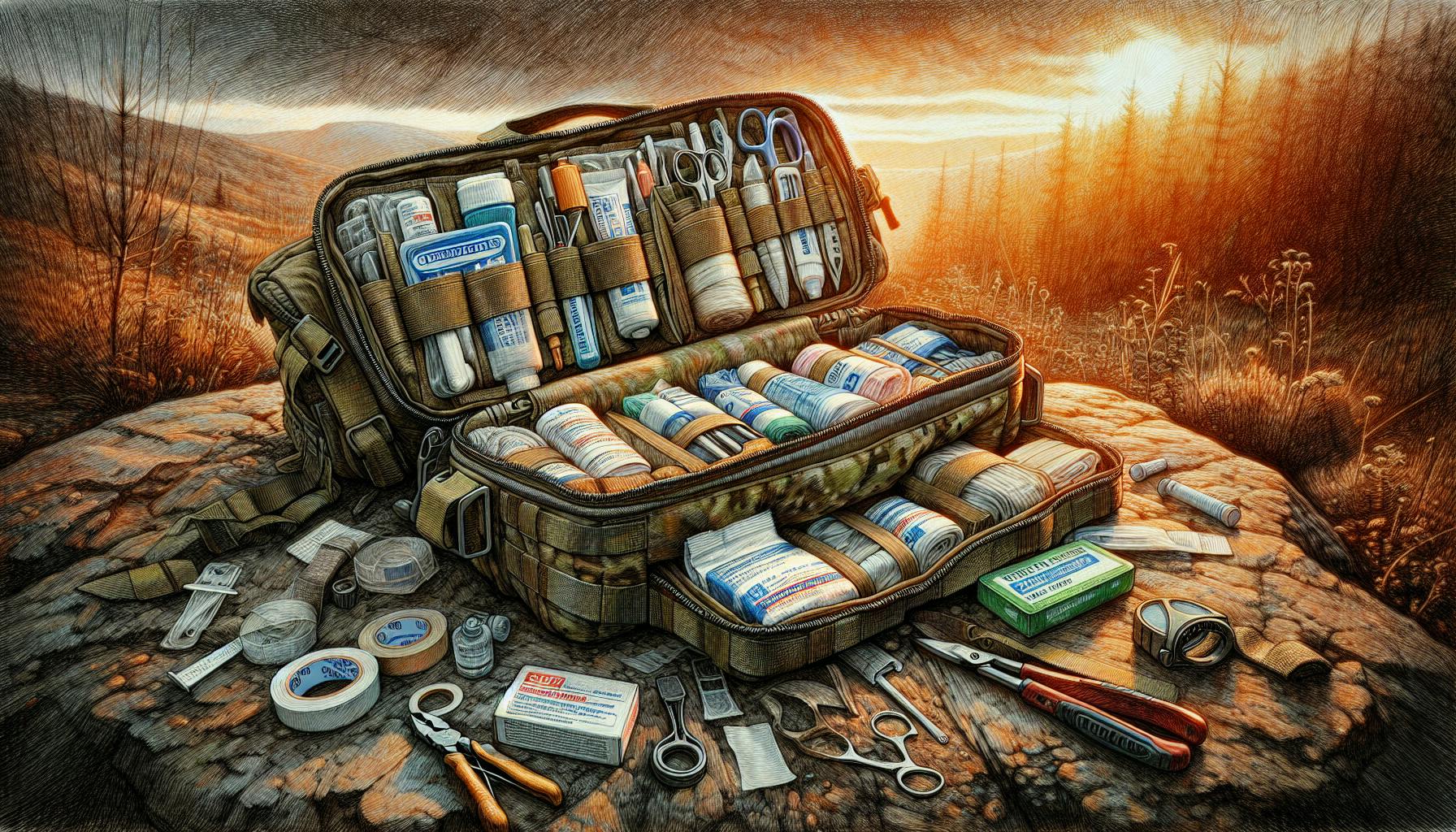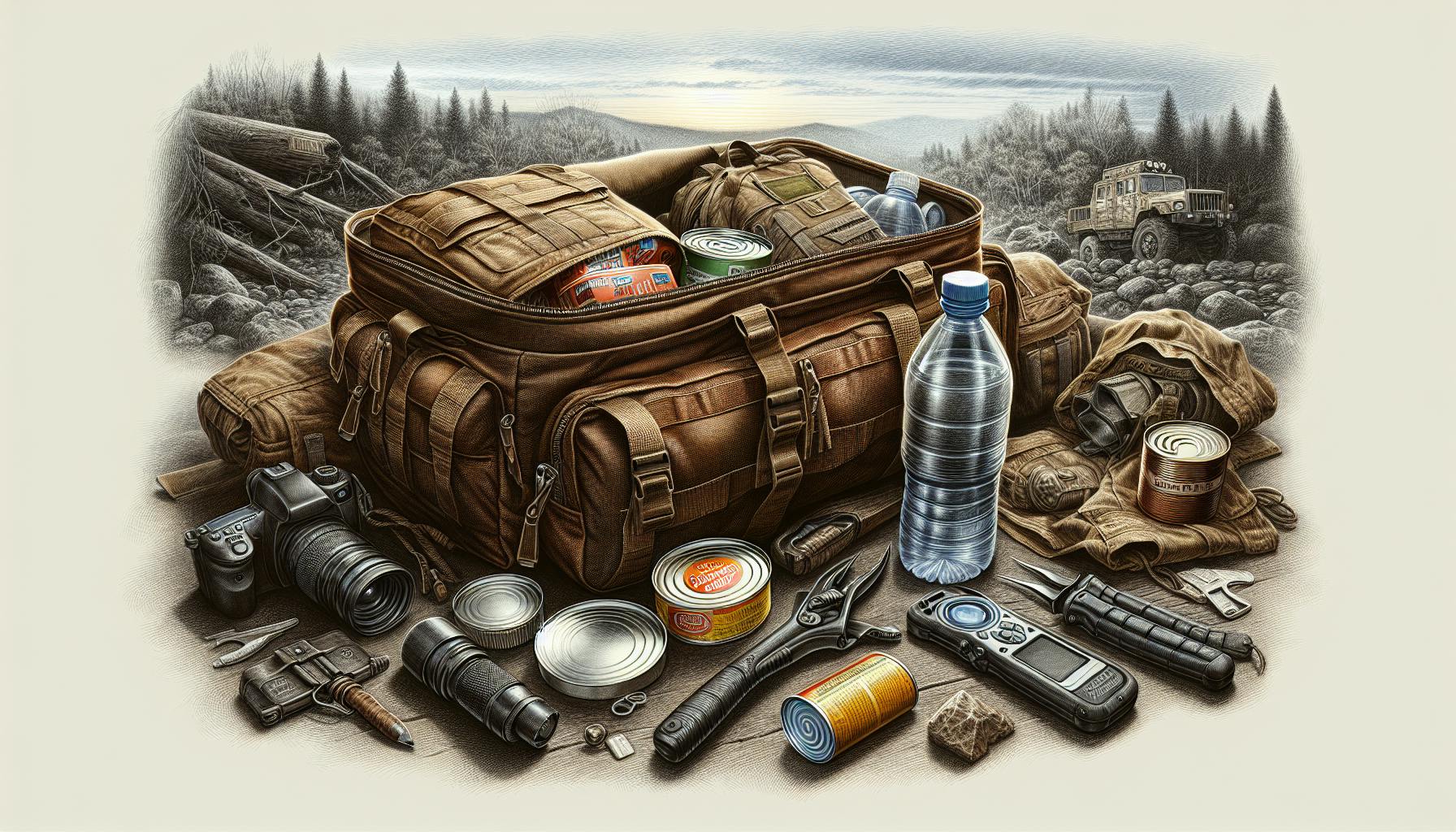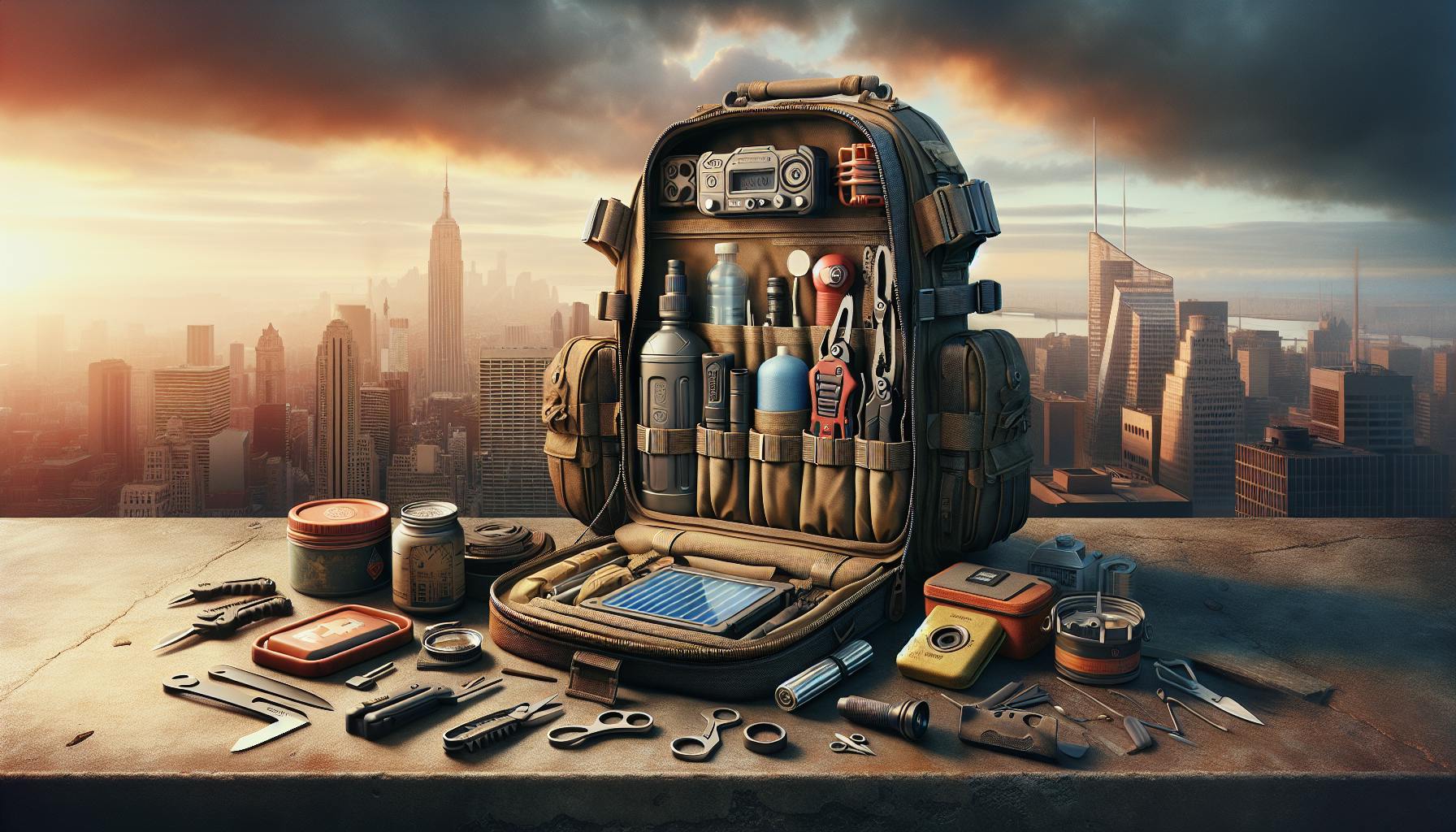When facing uncertain situations, most people would agree that having some basic survival supplies can provide peace of mind.
With some thoughtful planning and preparation, you can assemble a compact yet versatile survival kit tailored to your specific needs.
In this article, we'll cover key criteria for building an effective small survival kit - from core elements like first aid to specialized gear for wilderness excursions. You'll get tips on customizing your kit, taking advantage of pre-made options, and maintaining supplies so they're ready when you need them.
Introduction to Small Survival Kits
Having a small, compact survival kit is an essential part of emergency preparedness. The key to a good small survival kit is having the small survival kit contain the most critical items needed to survive various emergency situations in a portable, lightweight package.
When assembling your small survival kit, focus first on the absolute essentials - items related to wilderness survival kits meeting basic needs like hydration, nutrition, first aid, navigation and signaling for help. Good choices include:
- A reusable water bottle and water purification tablets
- High-calorie, non-perishable food like energy bars
- Bandages, gauze, antibiotic ointment
- Whistle, signal mirror, flashlight or headlamp
- Map, compass, fire starter
The next consideration is tailoring the contents based on likely emergency scenarios. For example, if preparing for natural disasters, include dust masks, emergency blankets and cash. Those facing extreme cold weather would pack hand warmers and extra insulation.
Finding a compact, durable case like a small backpack or dry bag is also important when assembling your Best survival kit. Look for containers that are lightweight, waterproof and have ample interior storage options to organize all the items. Hard-sided cases with customizable foam provide maximum protection.
When packed properly, a thoughtfully assembled small survival kit provides quick access to the most vital gear and supplies, potentially saving your life in an emergency situation. Investing time to carefully select and store the contents is well worth the effort.
Criteria for the Best Survival Kit
When assembling a small survival kit, it's important to choose items carefully based on key criteria like versatility, compactness, durability, and customization. By optimizing for these factors, you can build a reliable, portable kit tailored to your unique needs.
Versatility and Multi-Function Items
Choosing versatile, multi-purpose gear is crucial for a compact survival kit. Opt for items that can serve more than one function, such as a pocket knife with multiple tools or a bandana that can be used as a sling, tourniquet, or water filter. Multi-function items maximize utility while minimizing the space and weight of your portable safety net.
Compactness and Portability
Focus on compact, lightweight gear that won't weigh you down. Prioritize critical tools over bulkier items. For example, a small signaling mirror takes up little room but allows you to signal for help. Mini versions of tools like compasses, fire starters, and fishing hooks keep your safety kit as portable as possible without sacrificing essential functions.
Durability and Reliability
In an emergency situation, you need gear that works when you need it. Thoroughly test and research items to ensure they are durable and reliable. Choose hard-wearing materials built to withstand the elements. Frequently inspect and service kit items to confirm they remain in good working order. Investing in quality survival tools provides peace of mind that your emergency kit will perform when it matters most.
Customization for Individual Needs
While some basic functions are universal, personalize your kit around your specific skills, locations, and potential scenarios. If hiking is your passion, consider an emergency blanket and blister kit. For urban environments, a small flashlight and multi-tool may prove more useful. Medical needs like medications and EpiPens are also vital personalizations. Customizing your compact survival kit to your lifestyle and needs ensures you have the right gear when faced with adversity.
Reviewing and Updating the Kit
As personal situations and products change, regularly review and update your compact survival kit to keep it current. Inspect and replace expired items like food bars, medicine, and batteries. Upgrade to improved versions of tools as they become available. Add or remove gear to align with new needs, skills, locations, and likely risks. Staying on top of your portable preparedness ensures you can rely on your small survival kit when you need it most.
Building Your Emergency Survival Kit
Having a well-stocked emergency survival kit is essential for being prepared when disaster strikes. This guide outlines the basic components every survival kit should include.
Core Survival Elements
The core elements for survival are:
- Water - Pack water purification tablets, a filter straw, or collapsible water bottle. Dehydration is dangerous.
- Fire - Include matches, a lighter, fire starters, and tinder to start a fire for warmth and signaling.
- Shelter - Have a space blanket, tarp, bivvy sack, or small tent to protect from the elements.
- Signaling - Flares, mirror, whistle, and high visibility vest should be in the kit for rescue signaling.
First Aid Essentials
Medical issues are common in emergencies. Be equipped to treat injuries with:
- Bandages, gauze, tape
- Antibiotic ointment
- Burn cream
- Medications
- Trauma shears
A first aid reference guide can also be useful.
Nutrition and Hydration
Having the right nutrition is vital. Include:
- High calorie protein bars or dried foods
- Water purification tablets or filter
- Mess kit and utensils
Rotate and replace food every 6-12 months to keep it fresh.
Tools and Equipment
Useful items include:
- Knife
- Emergency blanket and hand warmers
- Flashlight or headlamp with batteries
- Multitool
- Paracord
- Duct tape
Choose gear that is durable, multipurpose, and appropriate for your needs.
Protection from the Elements
Carry items to shield from the weather such as:
- Rain poncho
- Extra socks
- Thermal base layers
- Hat and gloves
- Sunscreen
Adjust clothing and gear for the climate and conditions you may face.
Having the essential elements in a compact, portable emergency survival kit can be invaluable if caught in a dangerous scenario outdoors. Tailor your kit to your specific needs.
sbb-itb-b932644
Wilderness Survival Kits: Special Considerations
Adapting a small survival kit for wilderness scenarios requires some additional considerations to account for navigation, potential encounters with wildlife, and the prospect of prolonged exposure to the elements.
Navigation Tools
Having the proper navigation tools can be critical when venturing into remote wilderness areas. Useful items to include are:
- A compass to determine direction and orientation
- Topographic maps of the area for navigation
- Optionally, a GPS device for more precise positioning (but ensure batteries are fresh)
Protection Against Wildlife
Dangerous encounters with bears, mountain lions, snakes, and other wildlife are a possibility in the wilderness. Carrying deterrents can help scare animals away and protect yourself if necessary:
- Bear spray has a range of 30+ feet to stop bears and other aggressive animals
- A signal whistle creates an unpleasant noise to scare away curious animals
- Snake bite kit can suction venom and reduce tissue damage
Extended Shelter and Warmth
You may need to create an emergency shelter and maintain warmth for an extended period while awaiting rescue. Useful items include:
- A tube tent or bivy sack provides lightweight, weatherproof shelter
- An emergency blanket reflects 90% of radiant heat to retain warmth
- Waterproof matches and a stormproof lighter to maintain ability to create fire
- Extra base layers and socks to layer clothing for insulation
Food Procurement
For longer-term survival, you may need to procure food through hunting, fishing, or foraging. Consider packing:
- Fishing line and hooks
- Snares for small game
- A folding knife for preparing wild edibles
- A plant identification guide for safe foraging
Signaling for Rescue
To call for help and make yourself visible, carry:
- A signal mirror that can reflect sunlight 20+ miles
- Glow sticks for visibility at night
- Whistles to signal rescuers
- Flares or a strobe light for visibility from aircraft
Equipping your survival kit properly for the conditions can be the difference between life and death in a wilderness emergency. Careful planning and preparedness is key.
The Convenience of an Amazon Survival Kit
Amazon offers a wide selection of pre-made survival kits that provide a convenient option for those looking to prepare for emergencies without having to source each item individually. These kits come with essentials like food, water, first aid supplies, tools, and shelter already assembled and ready to store or carry.
Pre-Made Kit Advantages
Choosing a pre-made survival kit from Amazon has several advantages:
-
Saves time and effort - No need to research and gather supplies on your own. The kit comes packed with basics you'll need.
-
Cost-effective - Buying a full kit is often cheaper than purchasing items separately. Bundled pricing means savings.
-
Reputable brands - Established brands generally have good quality control and testing.
-
Portability - Kits come in easy-to-carry bags, cases, or buckets fitted for convenience.
-
Shelf life - Pre-made kits typically contain items with long expiration dates and replace perishables over time.
Key Components to Expect
Typical survival kits contain a combination of:
-
Nutrition - High calorie food bars, MREs, freeze-dried meals
-
Hydration - Water pouches or tablets for purification
-
First aid - Bandages, ointments, medicines, tools
-
Tools - Knives, paracord, fire starters, compass, flashlight
-
Shelter - Emergency tent, sleeping bag, matches
Kits may also have radio, whistle, mask, gloves, waste bags, and other essentials. Choose based on risks factors and length of use needed.
Quality and Brand Considerations
When buying a pre-made kit, check:
-
Brand reputation - Well-known brands inspire confidence in quality. Look at customer reviews.
-
Materials used - Durable tools and fabrics hold up better. Avoid cheaply made items.
-
Shelf life - Ensure food, medicine, batteries have long expiration dates.
-
Sizing - Pick the right size kit based on number of people and length of survival needs.
Top recommended brands on Amazon include Wise Food, Mountain House, Sol, Grizzly, and more.
Customizing Pre-Made Kits
Consider personalizing a pre-made kit with:
-
Regional maps and navigation - For your local terrain and landmarks
-
Prescription medicine - Such as heart, allergy etc that may be needed
-
Special food - Tailor taste preferences for morale
-
Extra tools - Based on skills and expected tasks
Customizing ensures the kit fits your specific situation versus a one-size-fits-all approach.
Reviewing Customer Feedback
Reading buyer reviews on Amazon listings provides helpful insight into real-world experiences with that particular kit. Check for feedback on:
-
Quality and durability of specific items
-
Ease of storage and portability
-
Taste and portion sizes of the food
-
Overall value for money
This can further inform your buying decision when selecting among the survival kit options.
Maintaining and Storing Your Small Survival Kit
Regular Maintenance Checks
It is important to periodically check the contents of your survival kit to ensure everything is in working order. Set a reminder to conduct maintenance checks every 3-6 months.
Go through each item and make sure it is not expired, damaged or missing. Check batteries and replace as needed. Inspect food/water for spoilage or leaks. Ensure tools are clean, sharp, and undamaged. Replace any degraded items.
Optimal Storage Solutions
The ideal storage location keeps your kit compact yet protected. Consider a sealed plastic container or bag to prevent damage. Store in an easily accessible spot like a closet shelf, garage, vehicle trunk, or secure outdoor location if bugs/rodents are an issue inside.
For portability, a backpack, duffel bag, or plastic storage bin with handle works well. Attach a list of contents to the outside for quick reference.
Accessibility and Portability
You never know when an emergency might occur, so your survival kit should be readily accessible to grab and go. Storing it in a vehicle, bug out bag, or near an exit in your home ensures you can quickly transport it.
Backpacks make kits portable for evacuations. For home storage, keep near emergency supplies or in a central, memorable location. A brightly colored container also helps identify the kit.
Protection from Damage
Protect contents from damage by storing in a durable, waterproof container. Pelican cases, waterproof bags/boxes, and sealed buckets work great.
Store kit off ground to prevent water damage. Avoid areas prone to pests that might chew through bags. Consider adding silica packs to absorb moisture. Pad sharp tools to prevent puncturing.
Training and Familiarity
Get hands-on practice using your kit to increase efficiency in emergencies. Set reminders to inspect it so you know exactly where items are located and how to use them. Include laminated instructions if needed.
Let everyone in your family examine kit contents as well so all are familiar. Check local community emergency training programs too.
Conclusion: The Essentials of a Small Survival Kit
Assembling a compact yet comprehensive survival kit requires carefully choosing essential items that cover your basic needs in an emergency situation. The specific components depend on your intended use, but some key elements to include are:
-
Water purification: Water filters, purification tablets, or a metal container to boil water are critical for safe hydration. Choose items that are lightweight and portable.
-
First aid: Bandages, gauze, antibiotic ointment, pain medication, safety pins, and gloves can treat injuries and prevent infections. Mini first aid kits are available.
-
Navigation: A map, compass, GPS device (if battery allows), or even just trail markers to avoid getting lost. Know your destination.
-
Illumination: Flashlight, glow sticks, fire starters to provide light and visibility. Candles work in sheltered areas.
-
Shelter: Emergency blanket, tarp, duct tape, and paracord to create shelter from elements. Hand warmers also protect from cold.
-
Tools: Knife, multi-tool, duct tape, fire starters. Choose versatile items with multiple functions. Consider personal needs.
-
Food: High protein, lightweight, non-perishable bars or pouches. Enough to sustain until help arrives.
Regularly refresh kit items to replace anything expired or degraded. Store in an organized, durable bag that is easily accessible and portable. The goal is having critical gear to stabilize an emergency situation until you can get to safety. Customize based on likely risks and personal needs.


